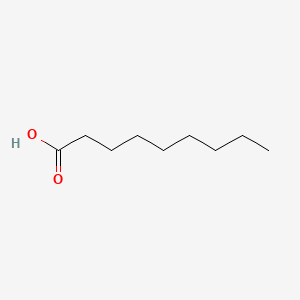| MeSH term | MeSH ID | Detail |
|---|---|---|
| Dermatitis, Contact | D003877 | 59 associated lipids |
| Facial Dermatoses | D005148 | 7 associated lipids |
| Hypersensitivity | D006967 | 22 associated lipids |
| Arteriosclerosis | D001161 | 86 associated lipids |
| Seizures | D012640 | 87 associated lipids |
| Dermatitis, Allergic Contact | D017449 | 20 associated lipids |
| Riboflavin Deficiency | D012257 | 10 associated lipids |
| Lichen Planus | D008010 | 3 associated lipids |
| Keratosis | D007642 | 9 associated lipids |
| Tick Infestations | D013984 | 4 associated lipids |
NONANOIC ACID
NONANOIC ACID is a lipid of Fatty Acyls (FA) class. Nonanoic acid is associated with abnormalities such as megalocytosis, Hypos, Renal tubular disorder, Respiratory Distress Syndrome, Adult and Little's Disease. The involved functions are known as Gene Expression, Signal Transduction, Regulation, Cell Cycle and Force. Nonanoic acid often locates in Membrane, Protoplasm, Body tissue, Extracellular and Cell membrane. The associated genes with NONANOIC ACID are cysteinylglycine, glycylsarcosine, arginine methyl ester, GLI3 gene and ADRBK1 gene. The related lipids are 1-octen-3-ol, Butyric Acids, palmitoleic acid, pentadecanoic acid and stearic acid.
Cross Reference
Introduction
To understand associated biological information of NONANOIC ACID, we collected biological information of abnormalities, associated pathways, cellular/molecular locations, biological functions, related genes/proteins, lipids and common seen animal/experimental models with organized paragraphs from literatures.
What diseases are associated with NONANOIC ACID?
NONANOIC ACID is suspected in megalocytosis, Hypos, Renal tubular disorder, Respiratory Distress Syndrome, Adult, Little's Disease and other diseases in descending order of the highest number of associated sentences.
Related references are mostly published in these journals:
- Am. J. Physiol. Heart Circ. Physiol. (1)
- Am. J. Physiol. Lung Cell Mol. Physiol. (1)
- Am. J. Physiol. Renal Physiol. (1)
- Others (1)
| Disease | Cross reference | Weighted score | Related literature |
|---|
Possible diseases from mapped MeSH terms on references
We collected disease MeSH terms mapped to the references associated with NONANOIC ACID
PubChem Associated disorders and diseases
What pathways are associated with NONANOIC ACID
There are no associated biomedical information in the current reference collection.
PubChem Biomolecular Interactions and Pathways
Link to PubChem Biomolecular Interactions and PathwaysWhat cellular locations are associated with NONANOIC ACID?
Visualization in cellular structure
Associated locations are in red color. Not associated locations are in black.
Related references are published most in these journals:
| Location | Cross reference | Weighted score | Related literatures |
|---|
What functions are associated with NONANOIC ACID?
Related references are published most in these journals:
| Function | Cross reference | Weighted score | Related literatures |
|---|
What lipids are associated with NONANOIC ACID?
Related references are published most in these journals:
| Lipid concept | Cross reference | Weighted score | Related literatures |
|---|
What genes are associated with NONANOIC ACID?
Related references are published most in these journals:
- Am. J. Physiol. Heart Circ. Physiol. (2)
- Acta Trop. (1)
- Am. J. Physiol. Lung Cell Mol. Physiol. (1)
- Others (3)
| Gene | Cross reference | Weighted score | Related literatures |
|---|
What common seen animal models are associated with NONANOIC ACID?
There are no associated biomedical information in the current reference collection.
NCBI Entrez Crosslinks
All references with NONANOIC ACID
Download all related citations| Authors | Title | Published | Journal | PubMed Link |
|---|---|---|---|---|
| Sehba FA et al. | Metamorphosis of subarachnoid hemorrhage research: from delayed vasospasm to early brain injury. | 2011 | Mol. Neurobiol. | pmid:21161614 |
| Cheng Q et al. | Biphasic effect of nitric oxide on the cardiac voltage-dependent anion channel. | 2011 | FEBS Lett. | pmid:21156174 |
| Waltenberger B et al. | Predicting cyclooxygenase inhibition by three-dimensional pharmacophoric profiling. Part II: Identification of enzyme inhibitors from Prasaplai, a Thai traditional medicine. | 2011 | Phytomedicine | pmid:20851587 |
| Ferreira-Dias G et al. | Nitric oxide stimulates progesterone and prostaglandin E2 secretion as well as angiogenic activity in the equine corpus luteum. | 2011 | Domest. Anim. Endocrinol. | pmid:20961721 |
| Schuppe H and Newland PL | Differential effects of nitric oxide on the responsiveness of tactile hairs. | 2011 | Invert. Neurosci. | pmid:21573755 |
| Clemmensen A et al. | Applicability of an exaggerated forearm wash test for efficacy testing of two corticosteroids, tacrolimus and glycerol, in topical formulations against skin irritation induced by two different irritants. | 2011 | Skin Res Technol | pmid:20923463 |
| Venter GJ et al. | The repellent effect of organic fatty acids on Culicoides midges as determined with suction light traps in South Africa. | 2011 | Vet. Parasitol. | pmid:21592665 |
| Szóstek AZ et al. | Ovarian steroids modulate tumor necrosis factor-α and nitric oxide-regulated prostaglandin secretion by cultured bovine oviductal epithelial cells. | 2011 | Domest. Anim. Endocrinol. | pmid:21420267 |
| Reierson GW et al. | cGMP Signaling, Phosphodiesterases and Major Depressive Disorder. | 2011 | Curr Neuropharmacol | pmid:22654729 |
| Sakuma S et al. | Perfluorinated carboxylic acids inhibit cyclooxygenase pathway more potently than 12-lipoxygenase pathway in rat platelets. | 2010 Oct-Dec | Prostaglandins Leukot. Essent. Fatty Acids | pmid:20678909 |
